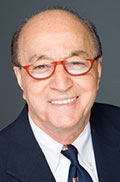About Dr. Abass Alavi
 Dr. Abass Alavi is a Professor of Radiology and Associate Director at the Institute on Aging at the University of Pennsylvania Perelman School of Medicine.
Dr. Abass Alavi is a Professor of Radiology and Associate Director at the Institute on Aging at the University of Pennsylvania Perelman School of Medicine.
Dr. Alavi is recognized as a pioneer in molecular and nuclear imaging, having contributed to the development of positron emission tomography (PET), in particular utilizing the radiotracer 18F fluorodeoxyglucose (FDG) in PET imaging, and later using 18F-FDG-PET in conjunction with computed tomography (CT) and magnetic resonance imaging (MRI) to understand diseases.
Working under the guidance of Dr. David Kuhl, Dr. Alavi and colleagues were pioneers in performing modern tomographic imaging by utilizing single gamma emitting radionuclides-- single photon emission computer tomography (SPECT).
In 1973, Drs. Alavi, Kuhl and Reivich devised the concept of labeling deoxyglucose with positron-emitting fluroide (18F), which lead to the development of FDG, the first clinically approved radiopharmaceutical for PET imaging that is still widely used today.
In August 1976, Dr. Alavi was part of the team, with mentor Dr. Kuhl, that performed the first human PET studies of the brain and whole body using18F-FDG. [1] He also was among the first to utilize iodine-123 in the diagnosis of thyroid cancer, meta-iodobenzylguanidine in the assessment of pheochromocytoma, radiolabled white blood cells in the evaluation of infection, and technetium 99m in the detection of gastrointestinal bleeds. Dr. Alavi, along with his wife, Dr. Jane Alavi, a specialist in hematology and oncology and Emeritus Associate Professor of Medicine at the University of Pennsylvania, pioneered the use of 18F-FDG PET for the demonstration of recurrent brain tumors.[1]
Dr. Alavi received his medical degree from University of Tehran School of Medicine in 1964. He did his post-graduate training as an intern (1966-1967) and first year resident (1967-1968) at Albert Einstein Medical Center in Philadelphia, a second year residency in medicine (1968-1969) at Veterans Administration Hospital in Philadelphia, a fellowship in hematology (1969-1970) at the Hospital of the University of Pennsylvania, a residency in radiology (1970-1971) at Beth Israel Hospital in Boston, and a fellowship in nuclear medicine (1971-1973) at the Hospital of the University of Pennsylvania.
Dr. Alavi’s over 1,500 journal articles have been cited over 75,000 times according to Google Scholar and he has received numerous awards, including the Georg Charles de Hevesy Nuclear Pioneer Award in 2004 and the Benedict Cassen Prize for Research in Nuclear Medicine of Society of Nuclear Medicine and Molecular Imaging (SNMMI) in 2012.
[1] Høilund-Carlsen PF. Abass Alavi: A giant in Nuclear Medicine turns 80 and is still going strong! Hell J Nucl Med. 2018 Jan-Apr;21(1):85-87. doi: 10.1967/s002449910713. Epub 2018 Mar 20. PMID: 29550853.
